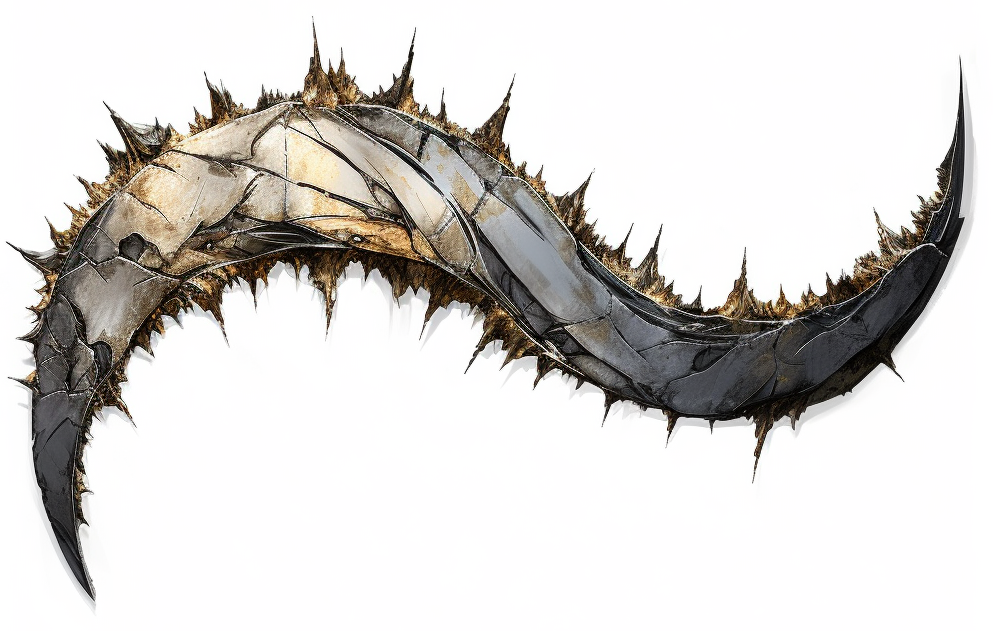Lower Planar Etiquette
by Turpental, tout most rorty
Something I’m most often asked by bashers new to the planes — at least, by those of them who tumble to the fact you don’t have to kill every fiend you meet to get along — is “What should I call them, demons or batzoo?”
My first answer is to chuckle and correct their pronunciation: For those of you who’ve never been to one of Factol Hashkar’s elocution lessons it’s bay-ART-zoo (or bay-ARTY-zoo if you’re from the Upper Planes, no really, they do talk like that there!) for the fiends from Baator (that’s BAY-ar-tor, berk!), and ta-NAR-ree for those from the Abyss (that’s ab-ISS, ha ha). By the by, it’s geh-REL-eth and YUGO-loth, while you’ve got me on the topic.
The next thing I do after that is to roll my eyes at the simple cluelessness of people. See, there’s this big issue in bodies’ minds about the correct naming conventions for fiends. Should we call them this, or that? Which is the polite term? Because, oh no, you wouldn’t want to be rude to a fiend, eh? Cobblers… rudeness is about the only language most of ’em understand!
Most planars use the “real” names of the races, baatezu, yugoloths and tanar’ri. I say “real” because it’s a cert these ain’t the actual names of any of these races at all. Who named them this, after all? Probably human explorers… no, they’re likely to be corruptions of the names the fiends call themselves if you ask this tout. Still, the mud stuck, and that’s the name to use if you want to appear to be a planar. Just make sure you pronounce them the way planars do or you risk making a lemon of yourself rather more than you risk offending a fiend! Calling a baatezu a tanar’ri is another matter — the baatezu in question is likely to either think you’re a fool (and then kill you) or think you’re mocking it (and then kill you). Either way, the outcome ain’t so good, eh?
Most primes tend to use the words “devil”, “demon” and “daemon”. However, it depends on where the prime’s from as to what each of those actually mean. For most they’re interchangeable; few primes I know understand the subtleties of Lower Planar politics, and most Krynnish berks don’t even know there are more than one fiendish race to begin with. Using these terms again doesn’t offend fiends in the slightest — you might imagine most are called far worse names in the course of an average day; at least, if they’re doing their job right they are. Technically, “devil” refers to fiends from Baator (just as “Hell” refers to Baator) and “demon” refers to fiends from the Abyss. The problem is, there’s more fiends in Baator than just the baatezu (just ask the kytons, div and rakshasa for starters) and many more in the Abyss than the tanar’ri (like obyrith, qlippoth, loumara, great old ones and so on).
Now “daemon” is just a silly word altogether, though some primes reckon it’s a name for yugoloths, and the ungainly “demodand” apparently means “gehreleth”, though most planars’ll just look at you blankly if you said it to ’em.
So, is it to be “demon” or “tanar’ri”, in polite fiendish company, you ask? Berk, that’s a rum question. For starters, polite fiendish company is the biggest oxymoron this side of the Harmonium. Fiends don’t care what they’re called. It’s more a matter of what you wish to sound like, a prime or a planar, when you’re talking about ’em. Remember, it can be useful to sound like a prime sometimes too — perhaps you’re trying to get away with saying you didn’t know better, or want to lull a berk into a false sense of security that you’re just a harmless clueless. There’s benefits to both, by my word, so my motto is think before you speak and don’t give too much away…
Watch the Spire!
Turpental
Source: Jon Winter-Holt

Hey, Good Looking…
by Turpental, tout most rorty
Why do Tanar’ri Look the Way they Do?
Some cutters are confused by the tanar’ri’s appearance. “How come”, they ask, “when the tanar’ri are supposed to be so very chaotic and evil, can they look so similar?” They’re wondering, I suppose why the race is divided so neatly into sub-species, true, lesser and least. Compare them with the hordelings, for example, who are a gibbering mass of mis-shapen beasts, no two looking alike, and I suppose I can see their point, for a moment at least. After all, hordelings are beings of pure evil, and not really chaotic at all. How can their appearance be so chaotic, when tanar’ri appear fairly uniform?
I’ll let you mull that thought for a moment…
Enough mulling now. Tumbled to the dark yet? My answer is the Abyss itself. Now, it’s all very well for Upper Planar types to be perfect examples of their philosophies, with the noble-animalistic guardinals, the jokey-faerie eladrin and the like, but they’ve got the advantage that their home planes ain’t constantly trying to kill ’em. The tanar’ri don’t have this silk glove luxury, cutter. The Abyss takes no prisoners, and if it senses a chance to kill a basher, it does so with relish, tanar’ri or not.
Some prime once burbled about something called “natural selection”. Hmm. On the prime that’s hogwash — any berk knows the powers made the animals and mortals just so — but out here in the Abyss, he’s got a point. Any tanar’ri that isn’t at the peak of its fitness, perfectly suited for its environment, sooner or later (actually sooner most times) is going to get trolley-whomped by its loving home plane and killed deader than Factol Skall.
Despite what you might think, tanar’ri ain’t stupid. They know weak from strong, and only a barmy’d choose to be weak on the Abyss. Likewise, any fiend making itself a new servant is going to by pretty dim to risk making something new that’s not going to survive. So any tanar’ri with half a choice over its next minion will pick one that’s tried and tested; a chasme, vrock, balor, the list is longer than my nose. Strike one; that’s one reson why tanar’ri are based on races — they’re already well-established as survivors. Tanar’ri beget new tanar’ri by squeezing larvae just so, and amongst the bloods who can do it, all the tricks for all the subraces are well known.
Not all tanar’ri get so lucky. There are many ways that tanar’ri are “born”, and one of them is for the plane itself to spontaneously spit them out like bile from an infected wound. Sometimes the “children” of the Abyss happen to fall just right, and turn into dretches, or manes or something. Most times, they ain’t so lucky, and they end up as horrible monstrosities unable to walk, breathe properly, or defend themselves against the marauding hordes.
These sods seldom live to be seen and catalogued by scholars! But sometimes, just sometimes, maybe when the planar winds blow just right, the newborn tanar’ri is something different, strong and alert, cunning enough to hold its own against attackers. And sometimes this new fiend might just grow up, and learn how to make more like itself…and that, dear reader, is how new tanar’ri races are born…
Watch the Spire!
Turpental
Source: Jon Winter-Holt

How can the Tanar’ri Outnumber the Baatezu?
How to Count to Infinity
According to planewalking sages, there are a number of possible reasons why the tanar’ri outnumber the baatezu:
There is an imbalance of chaos and law in the universe. The baatezu appeal to the higher temptations, such as pride, whereas the tanar’ri seem to appeal to the lower, more common evils — lust, for example. It’s far more common for evil berks to give in to the tanar’ri way of thinking than the baatezu — just look at all the murders and rapes committed out there in the planes every day.
The baatezu promotion scheme is far more rigorous than the tanar’ri. To gain ranks as a baatezu, you must live without any errors or mistakes for an awfully long time, persuade a senior fiend to back you up and generally work like the devil to get anywhere. On the other hand, the tanar’ri simply rely on might for promotion — any fiend can, and will, rise in rank if they can persuade others, by any means, that they are powerful enough to deserve it.
Finally, souls sent to the Abyss have a much greater chance of forming instant tanar’ri (although most still become larvae). In Baator new souls almost always form larvae, then have to go through the nupperibo stage, then be demoted to lemures, before they even start on the first rung of the long ladder to pit fiend-dom.
Source: Kris Aspinall

Infinite Evil, Limitless Disorder, Immeasurable Organisation
Being an Examination of the Nature of Evil, Its Relationship to Law and Chaos, and How This affects the Lower Planes of Baator and the Abyss
by the Sage of Everything
Part the First: Infinite Evil
The planes of Baator and the Abyss often cause those interested in the nature of evil much confusion. Baator has a finite number of layers, nine pits of increasing depravity. The Abyss, on the other hand, has an infinite (or at least uncounted) number of layers, each about as equally bad as the next. Indeed, there does not seem to even be any precedence to the layers. All the layers are equally deep. This has given rise to the speculation that the Abyss represents a more “true” evil than Baator does. This idea is quite incorrect. Evil is infinite. The two planes represent two very different forms of evil, but both planes contain infinite samples of the types of evil they embody.
Part the Second: The Effect of Law and Chaos
Why, then, if both planes contain infinite, does the Abyss have infinite layers, while Baator has a finite number? The answer lies not in the evil of the planes, but their chaos and law. The Abyss is chaotic. The Abyss represents disorganised evil, evil that turns on itself and has no purpose. Baator, on the other hand, is lawful and evil, evil that works with other evil for a definite goal. This division has a distinct effect on the nature of the planes. Baator’s evil, being lawful and hence organised, cooperates with itself. Similar forms of evil group themselves on layers. Each layer is infinite, so there is room for an infinite number of evils on each layer. Thus, the whole spectrum of organised evil can be fit into nine layers, with the more depraved examples near the bottom. The Abyss, on the other hand, cannot organise. Each layer of the plane represents one particular form of evil, or at most some evils that a greater evil has dominated and subsumed into itself. The layers are infinite because there is an infinite number of evils to fill them.
Part the Third: Supremacy of Layers
As all things in the Outer Planes, the Abyss and Baator are heavily influenced by belief. The layers evils are found on depend heavily on how the majority of believers see them. Baator tries to organise the evil according to severity. If a majority of believers think a particular evil is more or less depraved than another evil, then the plane will place the representation of that evil on a lower or higher layer, respectively. The Abyss, on the other hand, has no such organisation. There is a layer for every evil anyone has ever conceived of. Indeed, any particular evil is infinitely duplicated, a layer for every image or form an evil can take. Combinations of evils exist as well. For example, there are layers representing racism, layers representing genocide, and layers representing genocide and racism combined. For the same reason, no one layer is above or below any other. Numbering a layer of the Abyss is a pointless task. Any and every layer can be considered the “first.”
Part the Fourth: A Note on the Plane of Infinite Portals
Because it is the most commonly encountered layer, the Plane of Infinite Portals is often considered the first layer of the Abyss. As previously noted, however, there is no first layer to the Abyss. The Plane of Infinite Portals is so well connected to other planes because it represents the tendency of chaos and evil to spread.
A further note should be made here regarding the connection of the Abyss to the Astral plane. Normally, only the first layer of any given plane has a connection to the Astral plane. But no layer on the Abyss is the first. Or, put another way, every layer is. How, then, is is possible that only the Plane of Infinite Portals has a visible astral connection? The answer lies in belief. Most beings who know of the Abyss believe the Plane of Infinite Portals to be the first layer, so it acts as if it is. If a being who believed some other layer was the first came to the Abyss, they could only contact the Astral from the layer they believed in. Note that only one layer can be “believed” to have Astral contact at a time.
Source: Kelly Pedersen
A Rebuttal of this Essay by Anacoluthon of the Xaoticians
I challenge the idea that the number of layers of the Abyss is infinite.
As a mathematician, I’d like to point out that the number of layers of any plane, or members of any species, is at most aleph-null, the smallest possible measure of infinity.
In fact, the Abyss has finitely many layers according to most sources, but they shift and change so much, and are so unspeakable, that the potentiality of horrors it spawns is truly conceptually infinite. Infinite horrors yes, infinite layers no. An empirical test shows that there are finitely many (though as many as you need) tanar’ri, and that there are on average 600+ layers in the Abyss, although this fluctuates quite widely.
Source: Alex Roberts



Ohhh, is that a mention of some Pathfinder fiend groups? It will be really interesting to see it!
Fun fact, Pathfinder’s velstracs are not actually “kytons”, but unlike Planescape’s fiends, they are really pleased by comparison to one of the most powerful ones of their kind, the selfish perfectionists they are.
Heheh yep, a bit of foreshadowing there, you have sharp eyes, cutter! I’m planning on slotting the Pathfinder outsiders into the Planescape setting as optional extras — some of them are SO cool. Velstracs included! BTW, if you look up the archons on this here mimir you’ll see I’ve started doing that with those bashers already. Although I only did 2/3 of the congregations, need to finish that job (and some of the archons listed there are completely new too)…